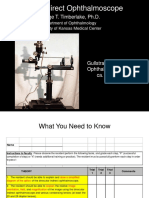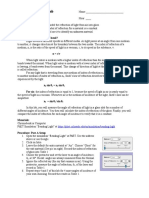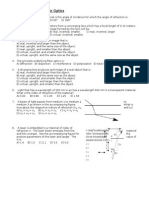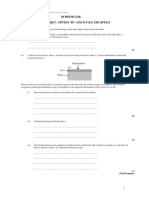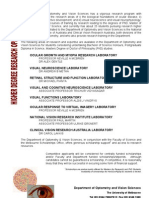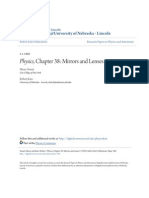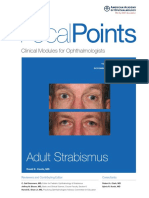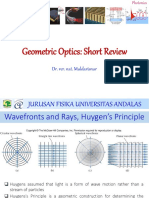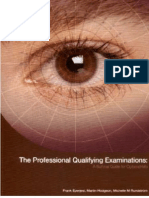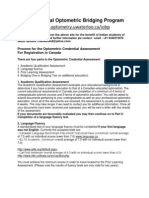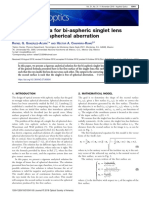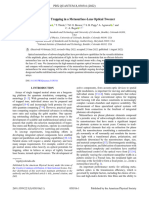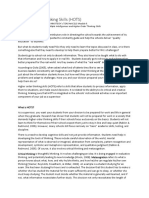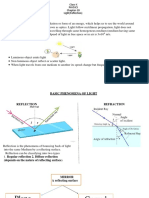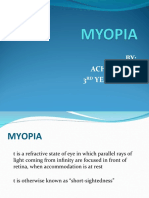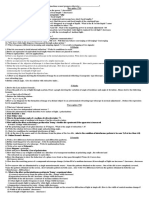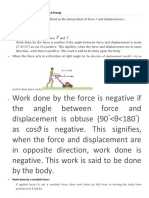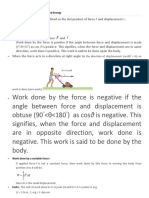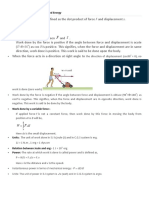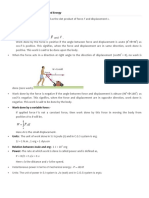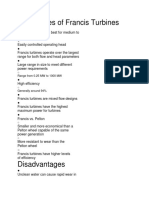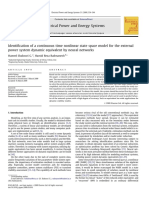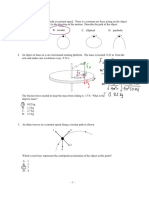Ray Optics & Wave Optics: Long Questions
Ray Optics & Wave Optics: Long Questions
Uploaded by
smrutirekhaCopyright:
Available Formats
Ray Optics & Wave Optics: Long Questions
Ray Optics & Wave Optics: Long Questions
Uploaded by
smrutirekhaOriginal Description:
Original Title
Copyright
Available Formats
Share this document
Did you find this document useful?
Is this content inappropriate?
Copyright:
Available Formats
Ray Optics & Wave Optics: Long Questions
Ray Optics & Wave Optics: Long Questions
Uploaded by
smrutirekhaCopyright:
Available Formats
Ray Optics & Wave Optics
LONG QUESTIONS
1. Write a neat ray diagram , explain the working of a compound microscope .Obtain the expression for its
magnifying power . [2+3+2]
2. Deduce the following formula for the material of a prism: [7]
𝐴+𝐷𝑚
𝑠𝑖𝑛
µ= 2
𝐴
𝑠𝑖𝑛
2
3. Explain a neat diagram describe the construction and working of an astronomical telescope [1+3+3]
1 1 1
4. For a concave mirror derive the expression 𝑢 + 𝑣 = 𝑓 also derive the expression for virtual image
1 1 1
5. Derive the expression 𝑢 + 𝑣 = 𝑓 for convex mirror.
6. How the compound microscope differ from simple microscope?
7. Difference between microscope and telescope with neat sketch.
8. Derive lens maker formula.
9. What is interference? Derive an expression for Young’s double slit experiment. Also write condition for
interference. [2+5]
10. Derive the relation between focal length and Radius of curvature. [7]
11. Explain about total internal reflection and also explain various application
12. What is the shape of the wave front in each of the following cases:
(a) Light diverging from a point source.
(b) Light emerging out of a convex lens when a point source is placed at its focus.
(c) The portion of the wave front of light from a distant star intercepted by the Earth.
13. Why is the focal length of an objective in compound microscope little shorter than the focal
length of the eyepiece?
14. Derive lens maker formula for double convex lens. State the assumptions and sign convention.
15. Obtain an expression for the focal length and power of the combination when two thin lenses are
placed in contact with each other.
16. what happens when a ray of white light passes through a prism ? discuss the phenomenon
analytically.
17. Prove that for small angles of incidence the deviation produced by a prism is independent of the
angle of incidence.
18. What is astronomical telescope ? Derive an expression for its magnifying power.
19. What is mirage ? Explain with neat sketch.
2 and 3 Marks Questions
1. Derive the relation R=2f
2. Distinguish between real image and virtual image.
3. The image of an extended object kept in front of the lens is found to be virtual, erect and diminished. What is the
type of the lens? Draw the neat sketch of ray diagram of the formation by the said lens.
4. Compare the objective and eyepiece of a compound microscope.
5. Draw a neat ray diagram to show the formation of image of a linear object by a convex mirror.
6. A concave is placed inside the water. Explain what change takes place in its focal length.
7. Draw a neat , labelled ray diagram to show the formation to show the formation of virtual image by a concave
mirror.
8. A ray of light enters into glass medium from air. Answer with reason what happens to its wavelength insight the
glass.
9. A simple magnifier can magnify the size of an object three times in distinct vision. Calculate its focal length.
10. Can a concave mirror ever produce a virtual image? Explain with ray diagram.
11. What are the conditions of interference of light waves [2010(A), 2007(A), 2007(A)]
12. What are the conditions of coherent of light waves
13. A simple microscope can magnify the size of an object three times in distinct vision. Calculate its focal length
[2008(A)]
14. Explain the effect of increasing the separation of slit in Young’s double slit experiment [2007(A)]
15. Prove that minimum distance between object and its real image in case of convex lens is 4 times its focal length.
16. Draw the ray diagram of simple magnifier. Give the expression its magnification.
17. Does the convex mirror ever produces a real image? Justify your answer with neat sketch.
18. What do mean by wave front?
19. What is condition for calculating dark fringe?
20. What is condition for calculating bright fringe?
21. What is fringe width? Write its condition.
22. Discuss the sign convention for rat optics . [2001(A)]
23. What do you mean by optical centre and principal focus of a lens [2001(I)]
1
24. Define critical angle .Prove that µ=𝑠𝑖𝑛𝐶
25. State Huygen’s principle for propagation of wave. What is the relation between a ray and wave front?
26. Explain wave particle duality.
27. How does the two lens of an astronomical telescope differ from each other? [1995(S)]
28. Why do you use a concave mirror for shaving purpose [1998 (A)]
29. What is refractive index?
30. Why is it that a right angled prism a better reflector than a plane mirrors?
31. What is the minimum distance between the object and the image in a double convex lens to have real image.
32. State the relation between critical angle and refractive index.
33. What is the focal length of the lens of a power 4 D?
34. When the convex lens does behaves as a concave lens? [2006]
35. An object placed 2f from centre of convex lens ,what is the nature and magnification of the image?
36. What is power of lens? How is it measure?
37. What is refraction? State the laws of refraction.
38. How does the refractive index of a material depend upon the wave length of light passing through it?
39. A ray suffers minimum deviation through a prism, how is its angle of refraction, in the prism, connected with the
angle of prism?
40. A ray of light is incident on shorter face of a right angled isosceles prism . What will be the deviation?
41. What is meant by minimum deviation of prism?
42. What change would occurs if the apparatus of Young’s double slit expected is dipped in water ?
43. How does the fringe width vary with the distance of screen from the two sources?
44. Explain what is dispersion and how it is produced by a prism.
Short Questions (1 Mark)
1. Can optical centre of a lens is always with the lens ?
2. When light travels from one medium to another medium, does its wavelength and frequency remains constant?
3. Which color having maximum refractive index?
4. Weather double concave lens produces real image?
5. Is there any medium which refractive index is less than one?
6. Which lens produces diminished image for all positions of the object?
7. What is the value of radius of curvature of plane mirror?
8. Which lens is used in automobile for view?
9. Weather focal length of lens depend upon the position of object?
10. Interference takes place in all waves. The statement is true or false?
11. Based on which principle optical fiber depend?
12. Define critical angle.
13. What is dispersion?
14. Explain the dual nature of light.
15. What is the refractive index with respect to velocity of light?
16. The refractive index of the material of an equilateral prism is √2 . what will be the angle of deviation for light ray
passing it?
17. The shortest distance between an object and its real image formed by converging lens of focal length 10cm is ----
-----(fill in the blank)
18. Your face appears magnified when you look at a mirror. What type of mirror is it ?
You might also like
- Frequency HTZDocument2 pagesFrequency HTZSrinathvr100% (1)
- Polarization by ScatteringDocument3 pagesPolarization by ScatteringJoe BalaNo ratings yet
- 9 Indirect OphthalmoscopeDocument63 pages9 Indirect OphthalmoscopeAriyanie NurtaniaNo ratings yet
- Refraction Phet Lab: ObjectivesDocument3 pagesRefraction Phet Lab: ObjectivesTạ Ngọc DiệpNo ratings yet
- Observing Interaction - An Introduction To Sequential AnalysisDocument221 pagesObserving Interaction - An Introduction To Sequential AnalysisVladimiro G. Lourenço100% (1)
- Beginning A Stem Research ProjectDocument13 pagesBeginning A Stem Research ProjectKahlil CayonNo ratings yet
- 13a-Waves and Optics MC Practice Problems - Section C Geometric OpticsDocument19 pages13a-Waves and Optics MC Practice Problems - Section C Geometric OpticsIan StantonNo ratings yet
- Aeroponic Based Controlled Environment Based Farming SystemDocument4 pagesAeroponic Based Controlled Environment Based Farming SystemIOSRjournalNo ratings yet
- Physics Review EM Waves & OpticsDocument26 pagesPhysics Review EM Waves & OpticsDiegophNo ratings yet
- LasersDocument23 pagesLasersdeedkumarNo ratings yet
- Waves and OpticsDocument3 pagesWaves and OpticsRiyaNo ratings yet
- Hooke's Law LabDocument5 pagesHooke's Law LabRyan WhiteNo ratings yet
- Investigation in OptometryDocument10 pagesInvestigation in Optometryrapid73No ratings yet
- Chatbot Learning Integration: Learners' Performance Enhancement ToolDocument7 pagesChatbot Learning Integration: Learners' Performance Enhancement ToolPsychology and Education: A Multidisciplinary JournalNo ratings yet
- OpticsDocument25 pagesOpticsSam LoveNo ratings yet
- Please Remember To Photocopy 4 Pages Onto One Sheet by Going A3 A4 and Using Back To Back On The PhotocopierDocument7 pagesPlease Remember To Photocopy 4 Pages Onto One Sheet by Going A3 A4 and Using Back To Back On The PhotocopierSyed Mairaj Ul HaqNo ratings yet
- Blur Retinal ImaginaryDocument1 pageBlur Retinal Imaginarymahmudneet720No ratings yet
- The Optical Quality of The CorneaDocument32 pagesThe Optical Quality of The CorneaacalossiNo ratings yet
- Al Refaee Optics PDFDocument264 pagesAl Refaee Optics PDFpjohnson1976100% (3)
- Physics, Chapter 38: Mirrors and Lenses: Digitalcommons@University of Nebraska - LincolnDocument25 pagesPhysics, Chapter 38: Mirrors and Lenses: Digitalcommons@University of Nebraska - LincolnRyan Busante Dela CruzNo ratings yet
- Professor Elwyn Mwika ChombaDocument1 pageProfessor Elwyn Mwika ChombaNewborn2013No ratings yet
- Simple Harmonic Motion Unit Plan 2014-03-26Document3 pagesSimple Harmonic Motion Unit Plan 2014-03-26sk112No ratings yet
- Experimental Verification of Snell's Law: Equipment ListDocument3 pagesExperimental Verification of Snell's Law: Equipment Listbdevlin822No ratings yet
- CH0MO0038s2007 PDFDocument103 pagesCH0MO0038s2007 PDFJulie Damiles-Aguilar BibbiganNo ratings yet
- Subject: Sample Outcomes-Based Curriculum For The Doctor of Optometry ProgramDocument18 pagesSubject: Sample Outcomes-Based Curriculum For The Doctor of Optometry ProgramJay R DomrigueNo ratings yet
- Contact Lens Fitting A Guide and Methodology of Contact Lens FittingDocument25 pagesContact Lens Fitting A Guide and Methodology of Contact Lens Fittingpinguitux100% (2)
- Adult StrabismusDocument16 pagesAdult Strabismusmataro13No ratings yet
- Lecture 3 Geometric Optics PDFDocument36 pagesLecture 3 Geometric Optics PDFPuja KasmailenNo ratings yet
- Magnetism (Revised)Document55 pagesMagnetism (Revised)api-275374056100% (1)
- The Professional Qualifying Examination1Document155 pagesThe Professional Qualifying Examination1Seica AlaNo ratings yet
- Ncle Exa1Document11 pagesNcle Exa1iannyaga450No ratings yet
- Pediatric OptometryDocument14 pagesPediatric OptometryDaman Fatima100% (1)
- (CSV) Collection - CSV Dec 2009 Competition Science Vision-Competition ScieDocument111 pages(CSV) Collection - CSV Dec 2009 Competition Science Vision-Competition ScieManas BeheraNo ratings yet
- Reflection and Refraction SimulationDocument5 pagesReflection and Refraction SimulationEduFeatNo ratings yet
- Foreign Optometrist For CanadaDocument9 pagesForeign Optometrist For CanadaABDUL HAMEEDNo ratings yet
- Prism (Autosaved)Document33 pagesPrism (Autosaved)Dasana SunnyNo ratings yet
- General Formula For Bi-Aspheric Singlet Lens Design Free of Spherical AberrationDocument5 pagesGeneral Formula For Bi-Aspheric Singlet Lens Design Free of Spherical AberrationSç-č AbabiiNo ratings yet
- Updated Ico Residency CurriculumDocument219 pagesUpdated Ico Residency CurriculumEdoga Chima EmmanuelNo ratings yet
- Metasurface Single Atom TrappingDocument11 pagesMetasurface Single Atom Trapping4pc9p5q7kb100% (1)
- Corneal ReflexDocument12 pagesCorneal Reflexgerald_azarconNo ratings yet
- Syl Optometry ReadDocument1 pageSyl Optometry ReadlaksmanaNo ratings yet
- Principles of Atoric Lens DesignDocument4 pagesPrinciples of Atoric Lens DesignsumedhikNo ratings yet
- 2-1 HOTS Overview and Blooms TaxonomyDocument6 pages2-1 HOTS Overview and Blooms TaxonomyElvin Nobleza PalaoNo ratings yet
- TMS 3728 TutorialDocument19 pagesTMS 3728 TutorialkhekhyNo ratings yet
- ICO Inst BK Clinical Optics Ref 2013 PDFDocument16 pagesICO Inst BK Clinical Optics Ref 2013 PDFElBuen John100% (1)
- CH 10 Light (Reflection 1)Document22 pagesCH 10 Light (Reflection 1)Mohammad MujtabaNo ratings yet
- TIE35-Transmittance of Optical GlassDocument9 pagesTIE35-Transmittance of Optical Glass侯涛No ratings yet
- Physics - Geometric-Optics Lesson PlanDocument3 pagesPhysics - Geometric-Optics Lesson PlanBeing MotivatedNo ratings yet
- Teaching Microscope Zeiss Primo StarDocument18 pagesTeaching Microscope Zeiss Primo StarAbd RaHmanNo ratings yet
- Ns Gr9 m1 Life ProcessesDocument43 pagesNs Gr9 m1 Life ProcessesEduBoardNo ratings yet
- HPH103 - Waves and Optics 1 - Lecture # 10-1Document45 pagesHPH103 - Waves and Optics 1 - Lecture # 10-1Praise NehumambiNo ratings yet
- BY: Achin Pant 3 Year MbbsDocument59 pagesBY: Achin Pant 3 Year MbbsMitali MohanNo ratings yet
- Lesson Plan Exemplar: (Derived From Assessment Standards)Document2 pagesLesson Plan Exemplar: (Derived From Assessment Standards)Carl AgoncilloNo ratings yet
- ICO Inst BK Clinical SC Text-Cvr 2014 1Document16 pagesICO Inst BK Clinical SC Text-Cvr 2014 1Edoga Chima EmmanuelNo ratings yet
- English: Language of ResearchDocument14 pagesEnglish: Language of ResearchSeungyun ChoNo ratings yet
- Brochure Occular PentacamDocument15 pagesBrochure Occular PentacamLuisEsparzaAvitia100% (1)
- PrismsDocument42 pagesPrismsa100% (2)
- Ico Inst BK Optics 2015Document16 pagesIco Inst BK Optics 2015Safa Abdualrahaman Ali HamadNo ratings yet
- Crst0412 - Phacopearls (Educating Patients About IOL Options)Document2 pagesCrst0412 - Phacopearls (Educating Patients About IOL Options)zaidoonys1No ratings yet
- Ray OpticsDocument11 pagesRay OpticsxkryxxzNo ratings yet
- Class 12 PhysicsDocument4 pagesClass 12 Physicsharun al hassan khanNo ratings yet
- OpticsDocument6 pagesOpticsAshok PradhanNo ratings yet
- Work done by the force is negative if the angle between force and displacement is obtuse (90 <θ<180) as cosθ is negative. This signifies, when the force andDocument3 pagesWork done by the force is negative if the angle between force and displacement is obtuse (90 <θ<180) as cosθ is negative. This signifies, when the force andsmrutirekhaNo ratings yet
- Work:-Work Done W Is Defined As The Dot Product of Force F and Displacement SDocument3 pagesWork:-Work Done W Is Defined As The Dot Product of Force F and Displacement SsmrutirekhaNo ratings yet
- Work:-Work Done W Is Defined As The Dot Product of Force F and Displacement SDocument2 pagesWork:-Work Done W Is Defined As The Dot Product of Force F and Displacement SsmrutirekhaNo ratings yet
- Work:-Work Done W Is Defined As The Dot Product of Force F and Displacement SDocument3 pagesWork:-Work Done W Is Defined As The Dot Product of Force F and Displacement SsmrutirekhaNo ratings yet
- Work:-Work Done W Is Defined As The Dot Product of Force F and Displacement SDocument3 pagesWork:-Work Done W Is Defined As The Dot Product of Force F and Displacement SsmrutirekhaNo ratings yet
- Work:-Work Done W Is Defined As The Dot Product of Force F and Displacement SDocument2 pagesWork:-Work Done W Is Defined As The Dot Product of Force F and Displacement SsmrutirekhaNo ratings yet
- Work:-Work Done W Is Defined As The Dot Product of Force F and Displacement SDocument2 pagesWork:-Work Done W Is Defined As The Dot Product of Force F and Displacement SsmrutirekhaNo ratings yet
- Work:-Work Done W Is Defined As The Dot Product of Force F and Displacement SDocument2 pagesWork:-Work Done W Is Defined As The Dot Product of Force F and Displacement SsmrutirekhaNo ratings yet
- Chapter 1thermodynamicsDocument21 pagesChapter 1thermodynamicssmrutirekhaNo ratings yet
- Work:-Work Done W Is Defined As The Dot Product of Force F and Displacement SDocument2 pagesWork:-Work Done W Is Defined As The Dot Product of Force F and Displacement SsmrutirekhaNo ratings yet
- Work:-Work Done W Is Defined As The Dot Product of Force F and Displacement SDocument2 pagesWork:-Work Done W Is Defined As The Dot Product of Force F and Displacement SsmrutirekhaNo ratings yet
- Optics 27 YearsDocument15 pagesOptics 27 YearssmrutirekhaNo ratings yet
- Work:-Work Done W Is Defined As The Dot Product of Force F and Displacement SDocument2 pagesWork:-Work Done W Is Defined As The Dot Product of Force F and Displacement SsmrutirekhaNo ratings yet
- Advantages of Francis TurbinesDocument2 pagesAdvantages of Francis TurbinessmrutirekhaNo ratings yet
- Unit X (Communication System) : Group-A 1 Mark EachDocument3 pagesUnit X (Communication System) : Group-A 1 Mark EachsmrutirekhaNo ratings yet
- Conceptual QuestionsDocument4 pagesConceptual QuestionssmrutirekhaNo ratings yet
- Text Ray OpticsDocument29 pagesText Ray OpticssmrutirekhaNo ratings yet
- Ray Optics - IDocument68 pagesRay Optics - IsmrutirekhaNo ratings yet
- Syllabus F19Document3 pagesSyllabus F19JRock555No ratings yet
- Business Plan Part L, LL & LLLDocument6 pagesBusiness Plan Part L, LL & LLLMaria Theresa Cortez MendozaNo ratings yet
- OTTV - MalaysiaDocument33 pagesOTTV - MalaysiaJulie TanNo ratings yet
- Chevelure enDocument4 pagesChevelure enNorman RochaNo ratings yet
- Superelevation of CurveDocument28 pagesSuperelevation of CurveMarc MathieuNo ratings yet
- Homework 01 SolutionDocument13 pagesHomework 01 SolutionAxeNo ratings yet
- Philippine Location LessonDocument13 pagesPhilippine Location LessonSharon Servidad-MonsaleNo ratings yet
- DC5000 8-311 PDFDocument2 pagesDC5000 8-311 PDFAnonymous tBL1suXNo ratings yet
- Get Curbside Consultation of the Shoulder 49 Clinical Questions First Edition Nicholson Md PDF ebook with Full Chapters NowDocument75 pagesGet Curbside Consultation of the Shoulder 49 Clinical Questions First Edition Nicholson Md PDF ebook with Full Chapters Nowerkeshkemgmo100% (6)
- Rubber Industry - Rsal-2Document33 pagesRubber Industry - Rsal-2SARVAGYA SHARMANo ratings yet
- Determination of The Contents of Cold DrinksDocument22 pagesDetermination of The Contents of Cold DrinkskavimudgalNo ratings yet
- Aesthetics of The Sublime and The Beauty BeethovenDocument45 pagesAesthetics of The Sublime and The Beauty BeethovenjieliNo ratings yet
- QUIZ #2 in PEDocument1 pageQUIZ #2 in PECrisselle Jane MagdayaoNo ratings yet
- SUEZ SelectHP Datasheet November2018Document2 pagesSUEZ SelectHP Datasheet November2018DAVIDNo ratings yet
- SOP Sewer Collection SystemsDocument14 pagesSOP Sewer Collection SystemsdexterNo ratings yet
- B09 Ryan Delacruz - Q2 Cont - Module3Document7 pagesB09 Ryan Delacruz - Q2 Cont - Module3Mark SalvadorNo ratings yet
- Rtu560 CMR02Document4 pagesRtu560 CMR02hemsabhati0% (1)
- T.2 Task 3 MomDocument2 pagesT.2 Task 3 MominesNo ratings yet
- FGSR Example Gas Emergency Escape PlanDocument36 pagesFGSR Example Gas Emergency Escape PlanAnonymous GfPSYi4nNo ratings yet
- CV 1707154196Document3 pagesCV 1707154196Vijay AnanthNo ratings yet
- KR 6 R1820 Arc HW: Teach PendantDocument1 pageKR 6 R1820 Arc HW: Teach PendantAHMED ghribiNo ratings yet
- Nextivity Cel-Fi Plug & Play Signal BoostersDocument28 pagesNextivity Cel-Fi Plug & Play Signal BoostersjuharieNo ratings yet
- DDC 232Document35 pagesDDC 232Gazza TNo ratings yet
- Grade 6 q2 Mathematics LasDocument151 pagesGrade 6 q2 Mathematics LasYZA BAYANo ratings yet
- Electrical Power and Energy Systems: Hamed Shakouri G., Hamid Reza RadmaneshDocument11 pagesElectrical Power and Energy Systems: Hamed Shakouri G., Hamid Reza RadmaneshMahra Rizvani PratamaNo ratings yet
- Pathfit EssayDocument8 pagesPathfit Essayjeffmyself901No ratings yet
- Mathematics Paper 1 TZ2 HLDocument19 pagesMathematics Paper 1 TZ2 HLsohamNo ratings yet
- Circular Motion Review Key PDFDocument21 pagesCircular Motion Review Key PDFKen HueyNo ratings yet


